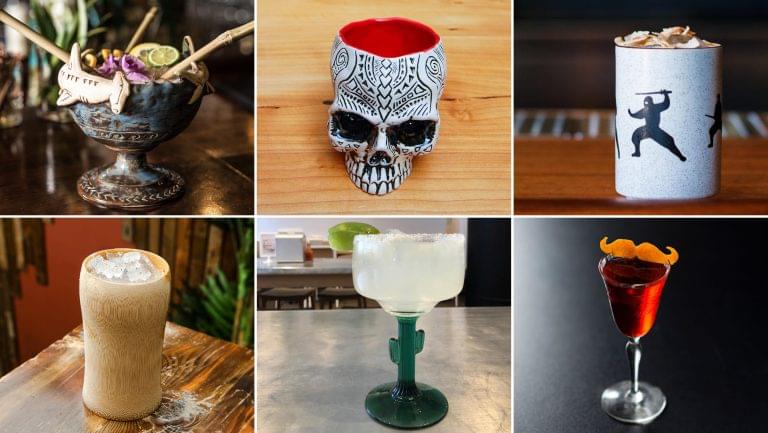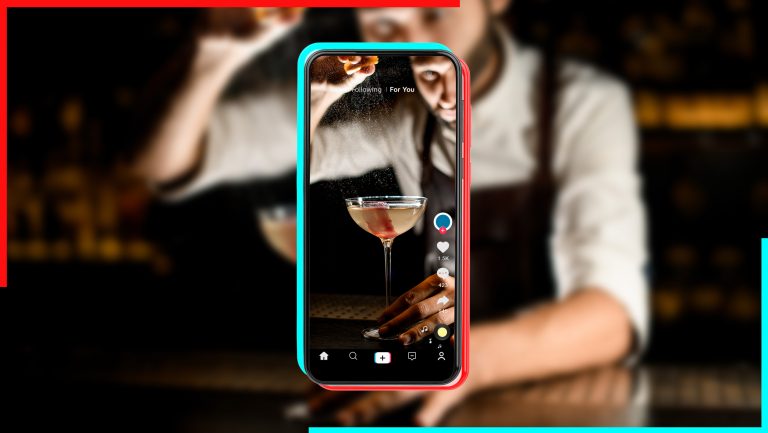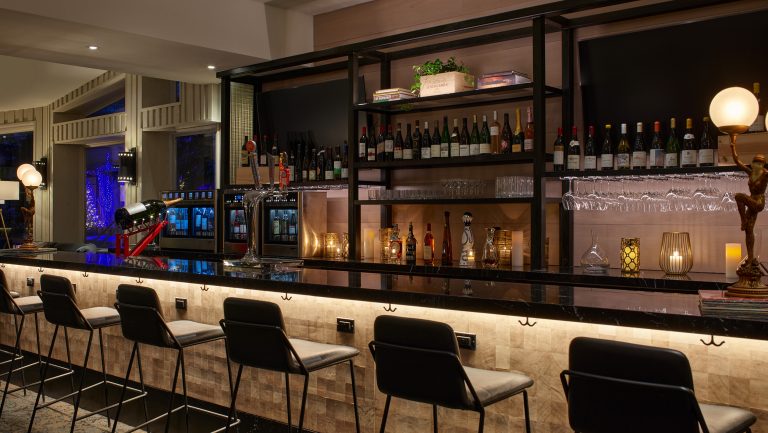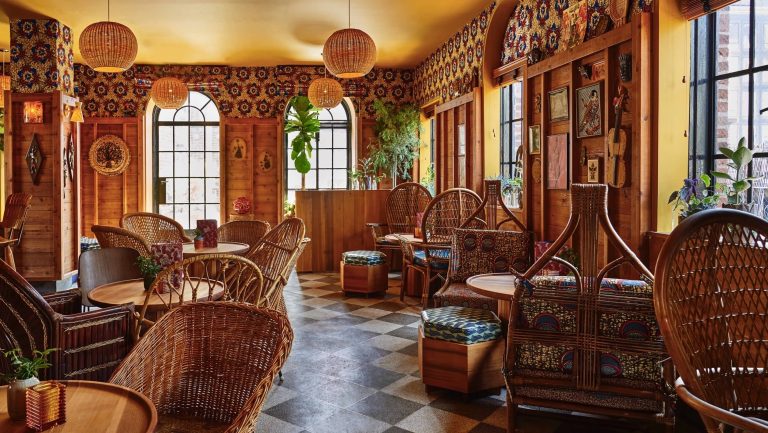From copper pineapples and tiki bowls to vintage crystal coupes, bars are cashing in on the novelty and Instagram-worthiness of funky glassware. Jennifer Seidman, the owner of Acme Bar & Company in Oakland, California, says of its vintage coupes, Collins glasses, and other barware, “Not only are they pretty but they tend to help justify a higher-priced drink.”
At The Ruin Daily in Chicago, Dylan Stewart, the general manager, says of the bar’s giant, cactus-shaped margarita glasses, “People see [them] and say, ‘Whatever that is, I want it, too!’” The glassware draws orders from guests who want to have a little fun. Says Stewart, “It doesn’t hurt that they’re great social media fodder as well.”
The positive sides of using fun and funky glassware are readily apparent: Unique glassware creates a point of differentiation for a bar, can drive social media posts, and can increase sales for whatever is served in them. But every silver lining has a cloud—the wilder, wackier vessels tend to walk out the door, and they’re hard to clean and stack. There are also environmental considerations, as some materials are ill-suited for humid conditions or outdoor use.

Don’t miss the latest drinks industry news and insights. Sign up for our award-winning newsletters and get insider intel, resources, and trends delivered to your inbox every week.
SevenFifty Daily spoke with operators around the country to learn their best practices for using and preserving novelty glassware.
Preventing Theft
The combination of lowered customer inhibitions and covetable drinking containers can make for an expensive proposition for bar operators. Most glassware can fit into a large purse or small backpack and be smuggled out of a venue unless theft-prevention schemes are in play.
Some bars hold a customer’s credit card or driver’s license as a deposit when handing over their expensive glassware. This became popular during the Moscow Mule copper mug craze of a few years ago, as copper (and even copper-colored) mugs sell at wholesale for more than $10 apiece. Other bars have made their deposit system a companion novelty feature—a few international bars exchange a drinker’s shoe for a beer stein, for example.
Kelley Fitzsimonds, a manager at Odd Birds in St. Augustine, Florida, sources all the bar’s vintage glasses from thrift stores in the area for less than $1 each. While some of it is spirited off, the bar instituted a simple theft-prevention plan: All glasses are available for sale. “Yes, people steal them from time to time,” Fitzsimonds says. “However, we’ll resell them if people fall in love with a particular one. It’s a set price of $5. We find this to be a fair price: low enough that it discourages theft, and high enough that people don’t clean us out like we do our local thrift stores.”
San Francisco’s Comstock Saloon offers a different solution for theft: The vintage glassware is available only to patrons sitting at the bar, where bartenders can keep a close eye on prized glasses. Table-seated patrons are given standard glassware.
Across town, Karri Kiyuna, the head bartender at Wildhawk, says the small cocktail bar offers several styles of fun glassware—some of it provided by liquor brands and some purchased, including ceramic mugs painted with ninjas and pandas. She says that while the glassware does tend to go missing, “we just try to keep a regular schedule to go to Japantown to buy more.” And when drinkers comment on how much they love the glasses, Kiyuna says, “usually a quick conversation will encourage guests to make a trip and pick out their own!”
Avoiding Breakage
With great glassware comes not-so-great washability. Vintage and crystal stemware tends to be quite thin and breakable, and much ceramic and unusually shaped glassware won’t fit into a typical dishwasher. Hand washing takes staff time and reduces the speed of customer turnover, and the glassware doesn’t stack up well once it’s clean.
Seidman of Acme says, “We hand-wash all vintage glassware, so it can be a pain. But I find [the glasses] don’t fit in many dish racks, and they break faster when machine washed. I try to buy glassware for $3 or less, so it’s actually cheaper than most mass-produced glassware.”
In addition to being easily breakable, odd-shaped glassware tends to take up a lot of space. “We hate [hand-washing every glass], but Thursday business is better because of it,” says Tamir Ben-Shalom, the bar director at Bull Valley Roadhouse in Port Costa, California, of the bar’s Tiki Thursday, where specialty glassware is used. Sales jump 10 to 15 percent higher on Tiki Thursdays than on typical weeknights, which Ben-Shalom attributes to the theme and the glassware. During regular weekday service, the tiki glassware is put away, and the bar features just two special glasses—a julep cup and a large-format glass that serves two to four people. Ben-Shalom says that those two vessels don’t put too much hand-washing pressure on the bartenders, and the servers and bussers stay vigilant to prevent theft.
The restaurant and bar Spork in Pittsburgh serves drinks in expensive Spiegelau glassware, tiki mugs, and Porthole infusers, depending on the menu, according to Sean Enright, the general manager. These vessels take up a fair amount of shelf space, but the restaurant planned ahead to accommodate glassware storage. “Our back bar was custom-designed to highlight this specialty glassware,” Enright says. “As we change seasons and menus, our glassware rotates in and out of display on the back bar. We are fortunate to have a good amount of space, which does give us a serious advantage over other locations when it comes to storing the glassware.”
The Right Glass for the Bar
In the wake of theft or the extra effort in care and handling, some bar operators have given up on specialty glassware entirely. Others found that unexpected challenges made them alter their glassware use.
In Honolulu, Jennifer Ackrill, the director of mixology at Top of Waikiki and Sky Waikiki, discovered that copper-plated vessels were no match for a humid environment. “We were using copper pineapples and they were a giant hit,” she recalls. “Everyone loved them. They looked beautiful and were a favorite of our guests, but the problem for us was that we are an outdoor venue, by the ocean, surrounded by a lot of sea air. Our beautiful shiny pineapples very quickly started to patina and we had to pull them. It was just a case of the right vessel in the wrong venue.”
Jay Schroeder, the bar director at Todos Santos in Chicago, encountered problems with wooden vessels. “When serving any cocktail in anything made out of wood,” he says, “be prepared to throw the vessel away after the first time it comes into contact with anyone wearing lipstick. If it’s unvarnished or if it’s porous in any way, the wax in the lipstick gets sucked into the pores. RIP cool cocktail glass.”
Buyer beware: Fun vessels may lead to increased social media posts and additional sales. But they also present a range of challenges. When possible, test out several types of glasses before making a large purchase order.

Dispatch
Sign up for our award-winning newsletter
Don’t miss the latest drinks industry news and insights—delivered to your inbox every week.
Camper English is an international cocktails and spirits writer, speaker, and consultant, with a focus on the science of booze and big clear ice. His work has appeared in Popular Science, Cook’s Science, Whisky Advocate, Saveur, Details, the San Francisco Chronicle, and many other publications.








